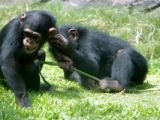It may be shocking but the genetic difference between you and the dumbest chimp is only around 1%. This might explain why so many people think and behave like chimps but, anyway, why don't they also look more like them? A new study has shown that having the same genes does not comprise the entire story: it also counts what genes get to be expressed.
A genome might be understood as a sort of recipe for building a living creature (be it an amoeba or a human). This recipe has such an ingenious structure that it's capable not only of storing the information but also of using it. The cook and the cook book are combined into one. But not everything in this recipe ends up to be used in the final product: some genes are expressed and some are not.
For example, a person with brown eyes might also carry a gene for blue eyes; but the blue eyes gene is less "powerful" and is not expressed. If the brown eyed person has a child with another brown eyed person who also carries a blue eyes gene, the child may turn out to have blue eyes. That's how the child may turn out having the same eye color as some of the grandparents' but different from both his parents.
The scientists from Yale, the University of Chicago, and the Hall Institute in Parkville, Victoria, Australia have now found that the large differences between us and chimps are also due to gene expression. This was hypothesized for the first time more than 30 years ago into a classic paper by Mary-Claire King and Allan Wilson. King and Wilson were the first to document the 99% similarity of genes between humans and chimps.
As I said: the cook and the cook book are one. In other words, there are certain genes that get expressed and some other genes that say which genes are to be expressed. The new study has employed a novel technique, called gene-array technology, and has shown that the difference that marked the separation of the original ape line into two branches, one toward chimpanzees and another toward humans, involved precisely a set of genes that control the expression of other genes.
As you might guess, even small changes of these regulatory genes can have an enormous impact. According to study author Yoav Gilad, assistant professor of human genetics at the University of Chicago, this is a very efficient way to make big changes with very little effort. By altering transcription factors, the entire regulatory network can change with very few mutations, increasing the impact and minimizing the risks that accompany any mutation. This is exactly the same mechanism that was identified by Marc Kirschner & John Gerhart, in their book The Plausibility of Life: Resolving Darwin's Dilemma, as the fundamental mechanism behind all evolution in general. Not surprisingly, the appearance of humans happened via the same mechanism. Now there is empiric evidence showing it.
The team of researchers compared the level of expression of more than 1,000 genes between humans, chimps, orangutans and rhesus macaques - representing about 70 million years of evolution.
"When we looked at gene expression, we found fairly small changes in 65 million years of the macaque, orangutan, and chimpanzee evolution," said Gilad, "followed by rapid change, along the five million years of the human lineage, that was concentrated on these specific groups of genes. This rapid evolution in transcription factors occurred only in humans."
"For 30 years scientists suspected that gene regulation has played a central role in human evolution," said Kevin White, associate professor of genetics and ecology and evolution at Yale and senior author of the study. "In addition to lending support to the idea that changes in gene regulation are a key part of our evolutionary history, these new results help to define exactly which regulatory factors may be important, at least in certain tissues. This helps open the door to a functional dissection of the role of gene regulation during the evolution of modern humans."
Besides showing how our Australopithecus ancestors had split ways with the chimpanzees, this study also indicated what genes seem to be of vital importance - the genes that evolution maintained unchanged for millions of years. Many of these genes are involved in basic cellular processes. The authors suggest that altering the regulation of these fundamental and ancient genes may be harmful and that this is where medical research should look for changes in order to find potential sources of various diseases such as cancer.
Of the 1,056 genes from all four species, 60 percent had fairly consistent expression levels across all four species. "The expression levels of these genes seem to have remained constant for about 70 million years," the authors wrote, "suggesting that their regulation is under evolutionary constraint."
Pictures credit: Marc Franco; Los Angeles Zoo

 14 DAY TRIAL //
14 DAY TRIAL // 
